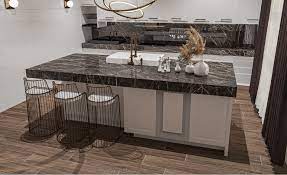In the realm of kitchen design, the island counter has become a quintessential element, combining aesthetics and functionality to transform culinary spaces into dynamic hubs of activity. Whether you’re envisioning a luxurious cooking haven or a versatile family gathering spot, the island counter stands as a centerpiece that adds both style and practicality to modern kitchens. In this article, we’ll explore the allure of island counters, their design versatility, and the myriad benefits they bring to the heart of the home.
The Focal Point of Kitchen Design:
An island counter serves as a focal point, anchoring the design of a kitchen with its commanding presence. Positioned strategically in the center of the room, it draws the eye and establishes a visual anchor that defines the overall layout. The island becomes not just a functional element but a statement piece, contributing to the aesthetic appeal of the entire kitchen space.
Versatility in Design Styles:
One of the remarkable aspects of island counters is their versatility in accommodating various design styles. From sleek and modern to rustic and traditional, the design possibilities are virtually limitless. Islands can be customized to complement the overall aesthetic of the kitchen, incorporating materials, colors, and textures that harmonize with the existing decor.
Multi-Functional Work Surface:
The primary function of an island counter is to provide additional workspace in the kitchen. This expansive surface area is invaluable for food preparation, chopping, and assembling ingredients. With the addition of built-in appliances such as a sink, cooktop, or even a built-in cutting board, the island becomes a centralized and efficient work zone, streamlining cooking processes.
Casual Dining and Entertaining:
Island counters have evolved beyond mere utility, becoming social hubs for casual dining and entertaining. Adding bar stools or high chairs to one side transforms the island into a convenient and inviting space for family and guests to gather. Whether it’s enjoying a quick breakfast, sipping coffee, or hosting a casual dinner party, the island counter facilitates a seamless transition from kitchen work to shared dining experiences.
Storage Solutions and Organization:
Incorporating storage solutions into the island counter enhances its functionality. Cabinets, drawers, and shelves can be seamlessly integrated to provide ample storage for kitchen essentials, utensils, pots, and pans. This not only optimizes organization but also reduces clutter in the main kitchen area, creating a more streamlined and efficient workspace.
Architectural Definition:
Island counters contribute to defining the architectural layout of the kitchen. They can delineate spaces in an open floor plan, creating a sense of structure and purpose within the larger room. Islands with distinct features, such as unique countertops, decorative paneling, or contrasting colors, become architectural statements that elevate the overall design aesthetic.
Showcasing Design Trends:
The island counter is an excellent canvas for showcasing design trends and innovations in kitchen decor. From waterfall countertops to bold color choices, pendant lighting, and mixed materials, islands allow homeowners to experiment with the latest design elements without overwhelming the entire kitchen space. This adaptability ensures that the kitchen remains a stylish and contemporary environment.
Integrating Smart Technology:
As kitchens evolve to embrace smart technology, island counters are adapting to accommodate these advancements. Incorporating built-in outlets, USB ports, or wireless charging stations into the island enhances its functionality, providing a convenient hub for charging devices, powering kitchen appliances, or even integrating smart home features.
Architectural Harmony with Open Concept Living:
For homes with an open-concept design, the island counter plays a crucial role in achieving architectural harmony. It provides a transitional element between the kitchen and adjacent living or dining spaces. The continuity of design, materials, and colors ensures a cohesive flow, creating a visually appealing connection between different functional areas.
Customization for Unique Needs:
The beauty of island counters lies in their adaptability to meet the unique needs of each homeowner. Whether you prioritize additional storage. A designated baking area, or a space for casual dining, the island can be customized to align with your lifestyle and preferences. This personalized approach ensures that the kitchen becomes a tailored and functional space that caters to your specific requirements.
Enhanced Traffic Flow:
Strategically designed island counters contribute to improved traffic flow in the kitchen. By creating clear pathways around the island, the overall functionality and safety of the kitchen are enhanced. This is particularly beneficial in larger kitchens where efficient movement between work zones is essential for a smooth and enjoyable cooking experience.
Increasing Property Value:
Investing in a well-designed island counter can significantly enhance the overall value of a property. Homebuyers often view a thoughtfully crafted and functional kitchen as a major selling point. An island counter that combines aesthetics, functionality, and the latest design trends can make a lasting impression and contribute to the market appeal of the entire home.
Conclusion:
The island counter has emerged as a dynamic and indispensable element in modern kitchen design. Its ability to blend aesthetics with functionality, adapt to various design styles, and cater to evolving lifestyle needs positions it as a centerpiece that transforms kitchens into lifestyle hubs. Whether used for culinary endeavors, casual dining, or socializing with loved ones. The island counter stands as a testament to the evolving nature of kitchen spaces. Where form and function seamlessly coexist to create inviting and innovative environments.

